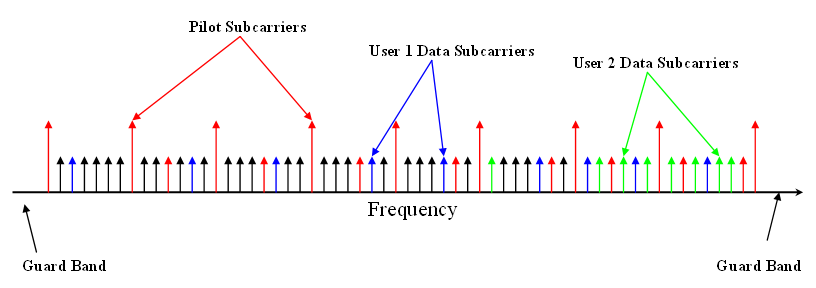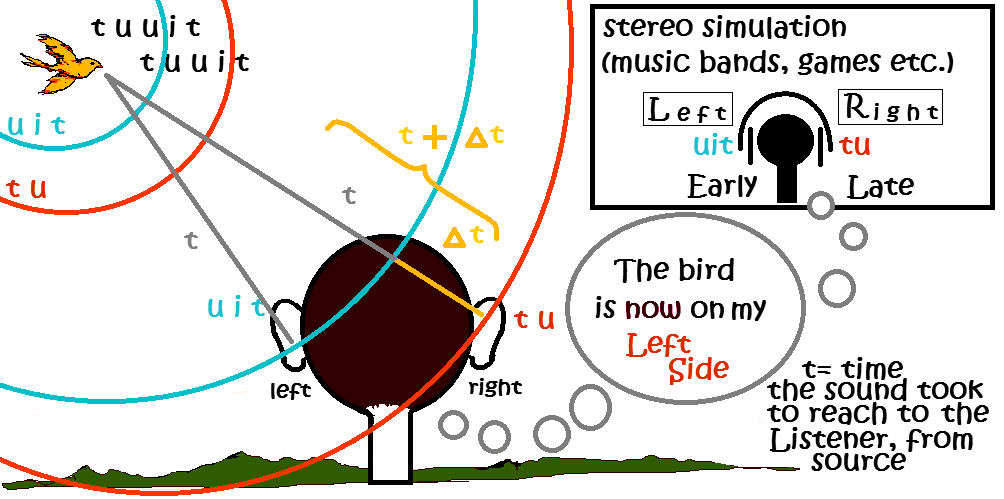|
Double-sideband
In radio communications, a sideband is a band of frequencies higher than or lower than the carrier frequency, that are the result of the modulation process. The sidebands carry the information transmitted by the radio signal. The sidebands comprise all the spectral components of the modulated signal except the carrier. The signal components above the carrier frequency constitute the upper sideband (USB), and those below the carrier frequency constitute the lower sideband (LSB). All forms of modulation produce sidebands. Sideband creation We can illustrate the creation of sidebands with one trigonometric identity: :\cos(A)\cdot \cos(B) \equiv \tfrac\cos(A+B) + \tfrac\cos(A-B) Adding \cos(A) to both sides: :\cos(A)\cdot +\cos(B)= \tfrac\cos(A+B) + \cos(A) + \tfrac\cos(A-B) Substituting (for instance) A \triangleq 1000\cdot t and B \triangleq 100\cdot t, where t represents time: :\underbrace_\cdot \underbrace_ = \underbrace_ + \underbrace_ + \under ... [...More Info...] [...Related Items...] OR: [Wikipedia] [Google] [Baidu] |
Amplitude Modulation
Amplitude modulation (AM) is a signal modulation technique used in electronic communication, most commonly for transmitting messages with a radio wave. In amplitude modulation, the instantaneous amplitude of the wave is varied in proportion to that of the message signal, such as an audio signal. This technique contrasts with angle modulation, in which either the frequency of the carrier wave is varied, as in frequency modulation, or its Phase (waves), phase, as in phase modulation. AM was the earliest modulation method used for transmitting audio in radio broadcasting. It was developed during the first quarter of the 20th century beginning with Roberto Landell de Moura and Reginald Fessenden's radiotelephone experiments in 1900. This original form of AM is sometimes called double-sideband amplitude modulation (DSBAM), because the standard method produces sidebands on either side of the carrier frequency. Single-sideband modulation uses bandpass filters to eliminate one of the ... [...More Info...] [...Related Items...] OR: [Wikipedia] [Google] [Baidu] |
Double-sideband Suppressed-carrier Transmission
Double-sideband suppressed-carrier transmission (DSB-SC) is transmission in which frequencies produced by amplitude modulation (AM) are symmetrically spaced above and below the carrier frequency and the carrier level is reduced to the lowest practical level, ideally being completely suppressed. In DSB-SC, unlike simple AM, the wave carrier is not transmitted; thus, much of the power is distributed between the side bands, which implies an increase of arial coverage in DSB-SC, for the same power consumption. DSB-SC transmission is a special case of double-sideband reduced carrier transmission. It is used for radio data systems. This mode is frequently used in amateur radio voice communications, especially on high-frequency bands. Spectrum DSB-SC is basically an amplitude modulation Amplitude modulation (AM) is a signal modulation technique used in electronic communication, most commonly for transmitting messages with a radio wave. In amplitude modulation, the instantaneo ... [...More Info...] [...Related Items...] OR: [Wikipedia] [Google] [Baidu] |
Quadrature Amplitude Modulation
Quadrature amplitude modulation (QAM) is the name of a family of digital modulation methods and a related family of analog modulation methods widely used in modern telecommunications to transmit information. It conveys two analog message signals, or two digital bit streams, by changing (''modulating'') the amplitudes of two carrier waves, using the amplitude-shift keying (ASK) digital modulation scheme or amplitude modulation (AM) analog modulation scheme. The two carrier waves are of the same frequency and are out of phase with each other by 90°, a condition known as orthogonality or Quadrature phase, quadrature. The transmitted signal is created by adding the two carrier waves together. At the receiver, the two waves can be coherently separated (demodulated) because of their orthogonality. Another key property is that the modulations are low-frequency/low-bandwidth waveforms compared to the carrier frequency, which is known as the In-phase and quadrature components#Narrowband ... [...More Info...] [...Related Items...] OR: [Wikipedia] [Google] [Baidu] |
FM Broadcasting
FM broadcasting is a method of radio broadcasting that uses frequency modulation (FM) of the radio broadcast carrier wave. Invented in 1933 by American engineer Edwin Armstrong, wide-band FM is used worldwide to transmit high fidelity, high-fidelity sound over broadcast radio. FM broadcasting offers higher fidelity—more accurate reproduction of the original program sound—than other broadcasting techniques, such as AM broadcasting. It is also less susceptible to Electromagnetic interference, common forms of interference, having less static and popping sounds than are often heard on AM. Therefore, FM is used for most broadcasts of music and general audio (in the audio spectrum). FM radio stations use the very high frequency range of radio frequency, radio frequencies. Broadcast bands Throughout the world, the FM broadcast band falls within the VHF part of the radio spectrum. Usually 87.5 to 108.0 MHz is used, or some portion of it, with few exceptions: * In the Commo ... [...More Info...] [...Related Items...] OR: [Wikipedia] [Google] [Baidu] |
Synchronous Detector
In electronics, a synchronous detector is a device that recovers information from a modulated signal by mixing the signal with a replica of the unmodulated carrier. This can be locally generated at the receiver using a phase-locked loop or other techniques. Synchronous detection preserves any phase information originally present in the modulating signal. With the exception of SECAM receivers, synchronous detection is a necessary component of any analog color television receiver, where it allows recovery of the phase information that conveys hue.Donald G. Fink (ed.)., ''Electronics Engineers' Handbook'', McGraw Hill, 1975 page 20-57 Synchronous detectors are also found in some shortwave radio receivers used for audio signals, where they provide better performance on signals that may be affected by fading In wireless communications, fading is the variation of signal attenuation over variables like time, geographical position, and radio frequency. Fading is often modeled as a ... [...More Info...] [...Related Items...] OR: [Wikipedia] [Google] [Baidu] |
Costas Loop
A Costas loop is a phase-locked loop (PLL) based circuit which is used for carrier signal, carrier frequency Carrier recovery, recovery from suppressed-carrier modulation signals (e.g. double-sideband suppressed carrier signals) and phase modulation signals (e.g. Phase-shift keying#Binary phase-shift keying (BPSK), BPSK, Phase-shift keying#Quadrature phase-shift keying (QPSK), QPSK). It was invented by John P. Costas (engineer), John P. Costas at General Electric in the 1950s. Its invention was described as having had "a profound effect on modern digital communications". The primary application of Costas loops is in wireless receivers. Its advantage over other PLL-based detectors is that at small deviations the Costas loop error voltage is \sin(2(\theta_i-\theta_f)) as compared to \sin(\theta_i-\theta_f). This translates to double the sensitivity and also makes the Costas loop uniquely suited for tracking Doppler-shifted carriers, especially in OFDM and GPS receivers. Classical imp ... [...More Info...] [...Related Items...] OR: [Wikipedia] [Google] [Baidu] |
Analog Television
Analog television is the original television technology that uses analog signals to transmit video and audio. In an analog television broadcast, the brightness, colors and sound are represented by amplitude, instantaneous phase and frequency, phase and frequency of an analog signal. Analog signals vary over a continuous range of possible values which means that electronic noise and interference may be introduced. Thus with analog, a moderately weak signal becomes Noise (video), snowy and subject to interference. In contrast, picture quality from a digital television (DTV) signal remains good until the signal level drops below digital cliff, a threshold where reception is no longer possible or becomes intermittent. Analog television may be wireless (terrestrial television and satellite television) or can be distributed over a cable network as cable television. All broadcast television systems used analog signals before the arrival of DTV. Motivated by the lower bandwidth requ ... [...More Info...] [...Related Items...] OR: [Wikipedia] [Google] [Baidu] |
Pilot Signal
In telecommunications, a pilot signal is a signal, usually a single frequency, transmitted over a communications system for supervisory, control, equalization, continuity, synchronization, or reference purposes. Uses in different communication systems FM Radio In FM stereo broadcasting, a pilot tone of 19 kHz indicates that there is stereophonic information at 38 kHz (the second harmonic of the pilot tone). The receiver doubles the frequency of the pilot tone and uses it as a frequency and phase reference to demodulate the stereo information. If no 19 kHz pilot tone is present, then any signals in the 23–53 kHz range are ignored by a stereo receiver. A guard band of ±4 kHz (15–23 kHz) protects the pilot tone from interference from the baseband audio signal (50 Hz–15 kHz) and from the lower sideband of the double sideband stereo information (23–53 kHz). The third harmonic of the pilot (57 kHz) is used for Radio Data System. The fourth harmonic (76 kH ... [...More Info...] [...Related Items...] OR: [Wikipedia] [Google] [Baidu] |
Subcarrier
A subcarrier is a sideband of a radio frequency carrier wave, which is modulated to send additional information. Examples include the provision of colour in a black and white television system or the provision of stereo in a monophonic radio broadcast. There is no physical difference between a carrier and a subcarrier; the "sub" implies that it has been derived from a carrier, which has been amplitude modulated by a steady signal and has a constant frequency relation to it. FM stereo Stereo broadcasting is made possible by using a subcarrier on FM radio stations, which takes the left channel and "subtracts" the right channel from it — essentially by hooking up the right-channel wires backward (reversing polarity) and then joining left and reversed-right. The result is modulated with suppressed carrier AM, more correctly called sum and difference modulation or SDM, at 38 kHz in the FM signal, which is joined at 2% modulation with the mono left+right audio (which ... [...More Info...] [...Related Items...] OR: [Wikipedia] [Google] [Baidu] |
Stereophonic
Stereophonic sound, commonly shortened to stereo, is a method of sound reproduction that recreates a multi-directional, 3-dimensional audible perspective. This is usually achieved by using two independent audio channels through a configuration of two loudspeakers (or stereo headphones) in such a way as to create the impression of sound heard from various directions, as in natural hearing. Because the multi-dimensional perspective is the crucial aspect, the term ''stereophonic'' also applies to systems with more than two channels or speakers such as quadraphonic and surround sound. Binaural sound systems are also ''stereophonic''. Stereo sound has been in common use since the 1970s in entertainment media such as broadcast radio, recorded music, television, video cameras, cinema, computer audio, and the Internet. Etymology The word ''stereophonic'' derives from the Greek (''stereós'', "firm, solid") + (''phōnḗ'', "sound, tone, voice") and it was coined in 1927 by ... [...More Info...] [...Related Items...] OR: [Wikipedia] [Google] [Baidu] |
Phase-locked Loop
A phase-locked loop or phase lock loop (PLL) is a control system that generates an output signal whose phase is fixed relative to the phase of an input signal. Keeping the input and output phase in lockstep also implies keeping the input and output frequencies the same, thus a phase-locked loop can also track an input frequency. Furthermore, by incorporating a frequency divider, a PLL can generate a stable frequency that is a multiple of the input frequency. These properties are used for clock synchronization, demodulation, frequency synthesis, clock multipliers, and signal recovery from a noisy communication channel. Since 1969, a single integrated circuit can provide a complete PLL building block, and nowadays have output frequencies from a fraction of a hertz up to many gigahertz. Thus, PLLs are widely employed in radio, telecommunications, computers (e.g. to distribute precisely timed clock signals in microprocessors), grid-tie inverters (electronic power converters used ... [...More Info...] [...Related Items...] OR: [Wikipedia] [Google] [Baidu] |






